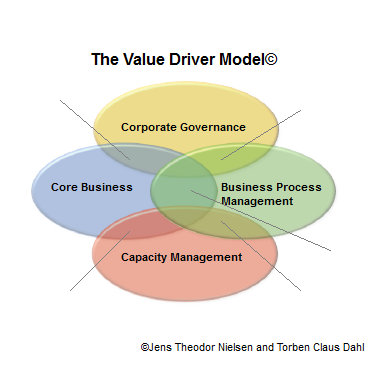Typically, the connection between formal business models and strategic concepts and strategies fail because of a missing mechanism
for transformation of the “way of thinking” into the “way of working”. Keeping the Value Driver Model© in mind, you will have a guideline
for how to transform the formal vision statements and the value policy from “Business Governance” into Programme Blueprints. De strategically
defined values and processes and KPIs discovered within “Value Management” provides the bridge.
The established high-level process
architecture together with the wider Enterprise Architecture should be used for reference when Corporate Governance is evaluating
underperformance, the viability of business modernisation ideas or reviewing business strategies. The architecture should also be
used as a reference for all development programmes by delivering Programme Blueprints and ensuring their consistency within the portfolio.
Again,
the Value Driver Model© tells us that BPM is the discipline due to which the strategic triple-intersection exists at all, and that
it can ensure a bridge between the strategic and tactical management in a company. The essential tool within BPM, the Business
Process Architecture established top-down through a process interpretation of the business model, is the reference describing the
value linkage.
To do the job, the BPM function must develop the process architecture and break down the identified main processes
into more detail. Interpreting these as a list of business processes, which must be actively monitored and managed to ensure continued
support of the strategic value management view.
What the Value Driver Model© tells a BPM function more specifically, is that
it should relentlessly promote the business process perspective. BPM should demonstrate its usefulness for strategic and tactical
evaluation of business performance and the BPM function should make sure it gets on the agenda when new programmes are considered
within Portfolio Management.







